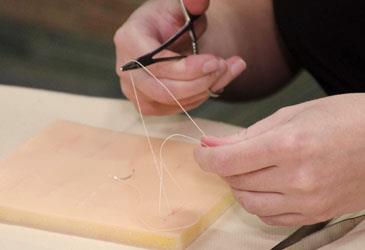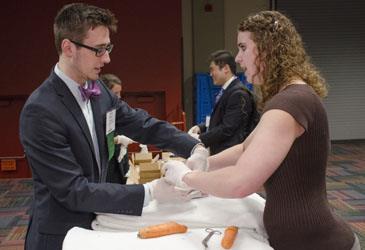The rising third-year student, tongue between his teeth, slowly drove his needle into a silicone pad meant to mimic human skin, then pulled his thread tight and started in again.
Theodore Zaki sealed up the gash with a classic horizontal mattress suture, not unlike the stitches in a baseball, then straightened up and took a satisfied breath.
“You want to do anything you can to avoid looking like an idiot on the first day,” said Zaki, a medical student at Yale School of Medicine, who is just two days from the start of his surgical rotation. “When the doctor hands me a needle and asks me to suture something up, I’ll definitely be prepared.”
Learning from mistakes and successes
It was that motivation to get ready that brought hundreds of students to a workshop on clinical skills during the 2016 AMA Annual Meeting. There they found a safe setting to make their mistakes and learn what they will need to know when they first treat patients. With guidance from experienced specialists, they tried their hands at not only suturing but airway management, radiology, hematology, orthopedics, prediabetes screening and blood pressure care.
Clinicians urged students to dive in with and sample every specialty they could. The workshops mean more comfort and confidence for students in their transition to caring for patients, Paul Glat, MD, said. He walked students through the finer points of suturing while others waited for their chance.
“Most have never held an instrument before,” said the plastic surgeon and professor of surgery at Drexel University College of Medicine in Philadelphia. “Surgery is a tough specialty—it’s sort of militaristic in a way. This is all about how not to stick themselves or another member of the team. It’s sort of self-preservation.”
Carrots and splints
Bales of carrots surrounded Jessica Brozek, MD, an orthopedic resident at the University of Kansas School of Medicine. But she wasn’t offering nutritional tips.
“I can’t really break your arm to show you, but we can break some carrots,” Dr. Brozek told a student. “Carrots break in the same way as arm bones.”
Fascinated students bunched around the carrots, then picked one. Some inflicted a transverse break, others a spiral or oblique. Then, with Dr. Brozek’s tutoring, they began mending.
Collin Shumate, who just finished his first year at Morehouse School of Medicine, rolled his fiberglass wrap too tightly at first. With a second effort and some coaching, he crafted a workable cast.
“You get to do something hands on and learn how to use the tools in the real world,” Shumate said.
Nearby, students did their best to intubate a mannequin and build airway management skills. Stephanie Winslow felt a particular motivation to “save” the mannequin known as Bob. A University of Florida College of Medicine student, Winslow will help conduct research during the summer before her second year on post-intubation morbidity and mortality. Her earlier work in an emergency room helped spark her passion for emergency medicine.
“I found myself in an ER as a scribe, and I fell in love with it,” she said. “I’ve always wanted to come back for more.”
Getting acquainted with specialties
Between hands-on workshops, students at the event also had the chance to pore over information on nearly 50 medical specialties and talk with physicians and residents in the field. Steven Hao, MD, helped acquaint students with cardiology.
“I remember vividly as a student, you had wide-open eyes, looking for opportunities, very idealistic,” said Dr. Hao. “These sessions are an opportunity to work with someone out in the real world and get an idea where your passions will take you.”
Student Gina Jamal took her turn with radiology, finding how tough it can be to route a catheter through a model torso. She started in a femoral artery and worked the tiny tube toward the neck and head. Turning and pulling, she found a sharp angle too hard to navigate.
“When I thought I had it, I didn’t,” said the rising second-year student at the University of Texas School of Medicine in San Antonio. “Honestly I think it was the user.”
Nevertheless, Jamal was among the countless students who cherished the chance to step out of the classroom and test-drive a variety of skills in something close to a real-care setting.
“I’m trying to get exposure to all I can,” she said. “This is the most fun event—all these specialties all in one place.”
The next AMA Clinical Skills Workshop will be offered Nov. 12 in Orlando as part of the 2016 AMA Interim Meeting.
Explore more practical tips for students
- Learn 7 clinical rotation tips from experienced physicians
- Consult this must-have checklist of tasks to prioritize during your first and second years of training. This will help you begin preparing a strong application for residency.
- Review a second checklist for success during your third year of med school
- Prepare for entering your fourth year with this roadmap to graduation and residency
- Master these 4 tricks to a successful residency program search
- Find out how many residency programs students really apply to each year





